Data table
Data tables are used to organize and display data efficiently. The data table component allows for customization with additional functionality, as needed by your product’s users.
Overview
The data table’s features are ideal for organizing and displaying data in a UI. The column headers can sort data in ascending or descending order, rows can be expanded to progressively disclose information, and single or batch actions can be taken on rows.
The data table toolbar gives a location for primary buttons, search, filtering, table display settings, and other utilities.
When to use
- To organize and display data.
- If your user must navigate to a specific piece of data to complete a task.
- Displaying all of a user’s resources.
When not to use
- When a more complex display of the data or interactions are required.
- As a replacement for a spreadsheet application.
Variants
| Variant | Purpose |
|---|---|
| Default | The default data table comes with a base style with only the title, header, and table elements. rows. |
| With selection | Batch actions are functions that may be performed on multiple items within a table. This variant of table enables the user to select individual rows and apply an action. A batch action toolbar appears when table rows are selected. |
| With expansion | The expandable data table is useful for presenting large amounts of data in a small space. Rows are collapsed and can be expanded to reveal extra information. |
Live demo
DataTable
Name | Protocol | Port | Rule | Attached Groups | Status |
|---|---|---|---|---|---|
| Load Balancer 3 | HTTP | 3000 | Round robin | Kevins VM Groups | Disabled |
| Load Balancer 1 | HTTP | 443 | Round robin | Maureens VM Groups | Starting |
| Load Balancer 2 | HTTP | 80 | DNS delegation | Andrews VM Groups | Active |
| Load Balancer 6 | HTTP | 3000 | Round robin | Marcs VM Groups | Disabled |
| Load Balancer 4 | HTTP | 443 | Round robin | Mels VM Groups | Starting |
| Load Balancer 5 | HTTP | 80 | DNS delegation | Ronjas VM Groups | Active |
<DataTable rows={rowData} headers={headerData}>{({ rows, headers, getHeaderProps, getTableProps }) => (<TableContainer title="DataTable"><Table {...getTableProps()}><TableHead><TableRow>{headers.map((header) => (<TableHeader {...getHeaderProps({ header })}>{header.header}</TableHeader>))}</TableRow></TableHead><TableBody>{rows.map((row) => (<TableRow key={row.id}>{row.cells.map((cell) => (<TableCell key={cell.id}>{cell.value}</TableCell>))}</TableRow>))}</TableBody></Table></TableContainer>)}</DataTable>
Formatting
Anatomy
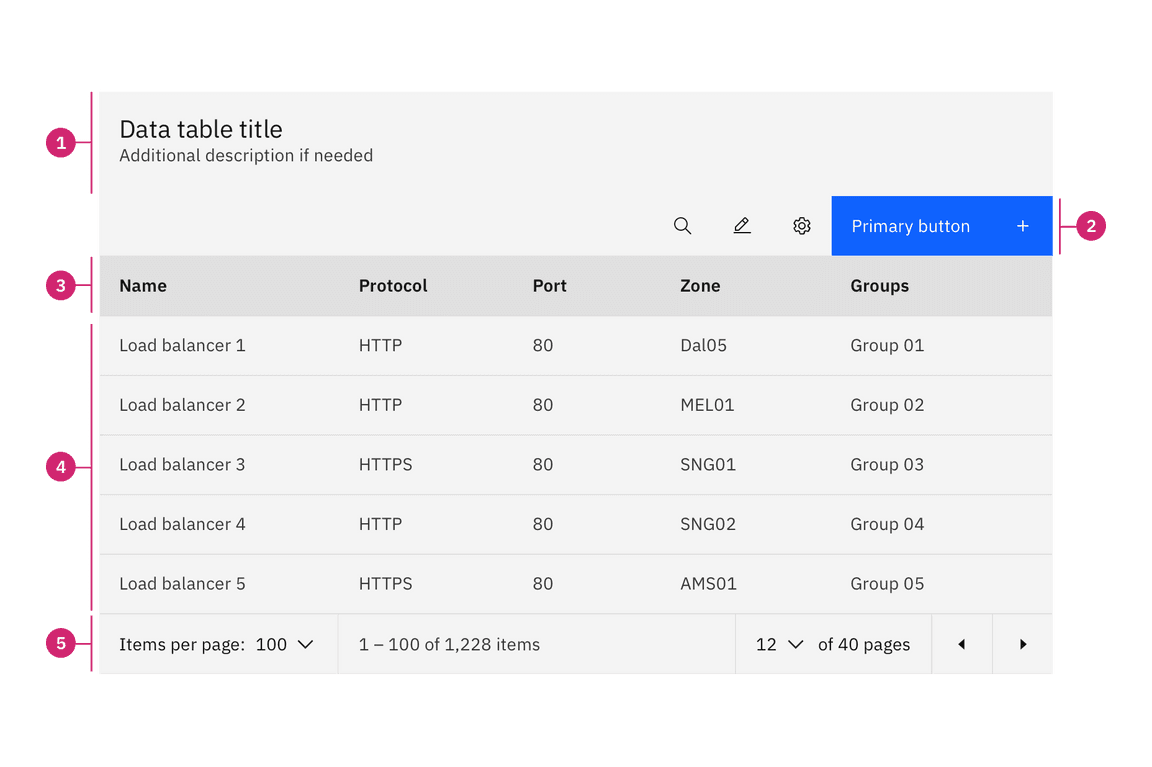
- Title and description: contains the data table title and an optional description.
- Toolbar: global data table controls including search and table settings.
- Column header: title for the row header with the optional sorting behavior.
- Table row: can be configured to show different types of data. Rows can be selectable, expandable, and modified to show alternating zebra stripe background colors.
- Pagination table bar: an optional component that lets a user navigate data as pages when the amount of data it too large to be shown at once.
Sizing
The data table is available in five different row sizes: extra large, large, medium, small, extra small.
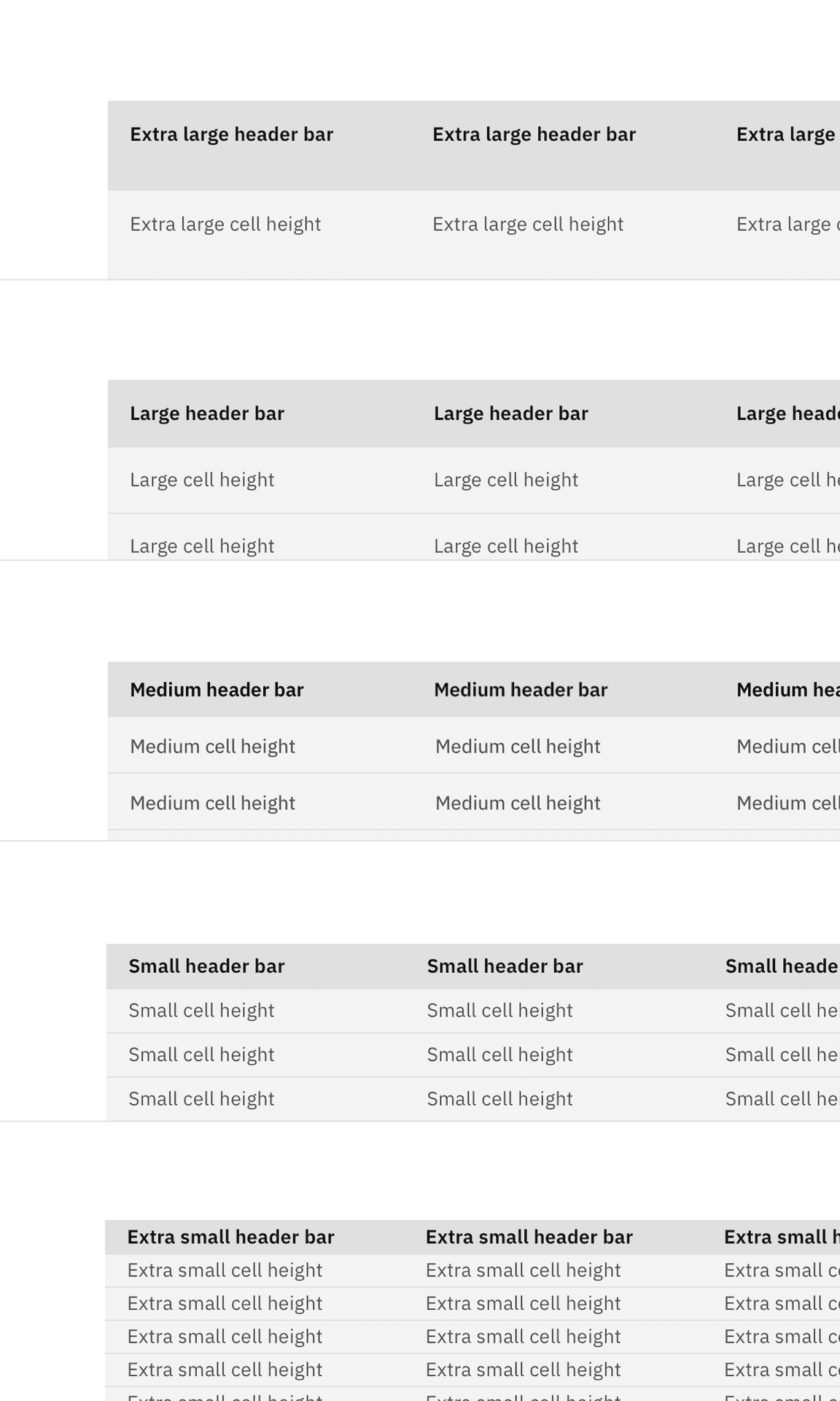
The column header row .cds--data-table thead should always match the row size
of the table. Extra large row heights are only recommended if your data is
expected to have 2 lines of content in a single row.
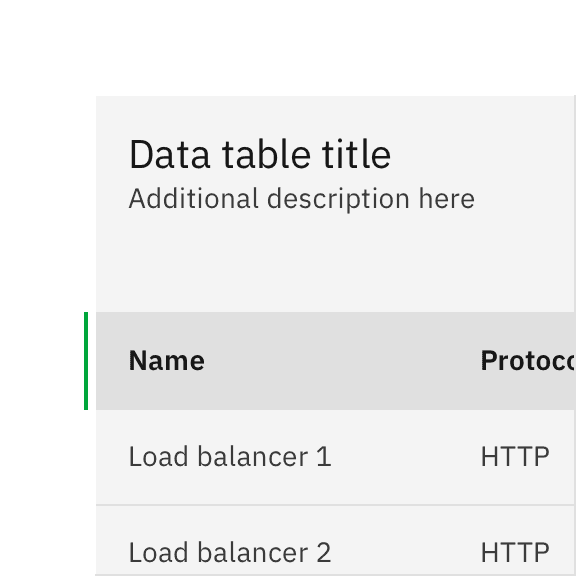
Do use the same row height for the table and header rows.

Don’t mix row heights for the table and header rows.
Two heights are available to be paired with the row heights of the data table. The tall toolbar should only be paired with the large and extra large row heights and the small toolbar should only be used with the small and extra small row heights.
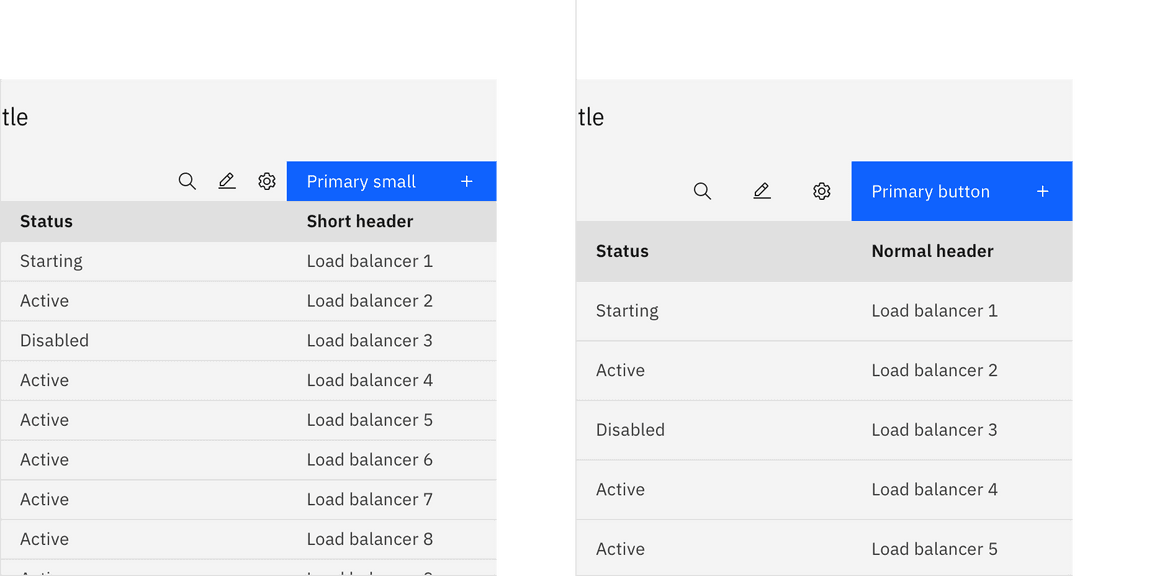
A small toolbar on a short data table and a tall toolbar on a normal data table
Placement
Data tables should be placed in a page’s main content area and given plenty of space to display data without truncation. Avoid placing data tables inside modals or smaller containers where the information can feel cramped or needs truncation.
The data table can be placed on the grid following the three different grid modes outlined in the 2x grid guidelines. Although, the data table can share horizontal space with other components and content, consider giving your data table the most width on the page to help your user view dense data.
These three examples show the data table on the wide (default), narrow, and condensed grid modes. Note the different type alignments and gutter sizes.
Wide grid mode
The wide grid mode is the default and gives the most breathing room between the data table and the other components or content.
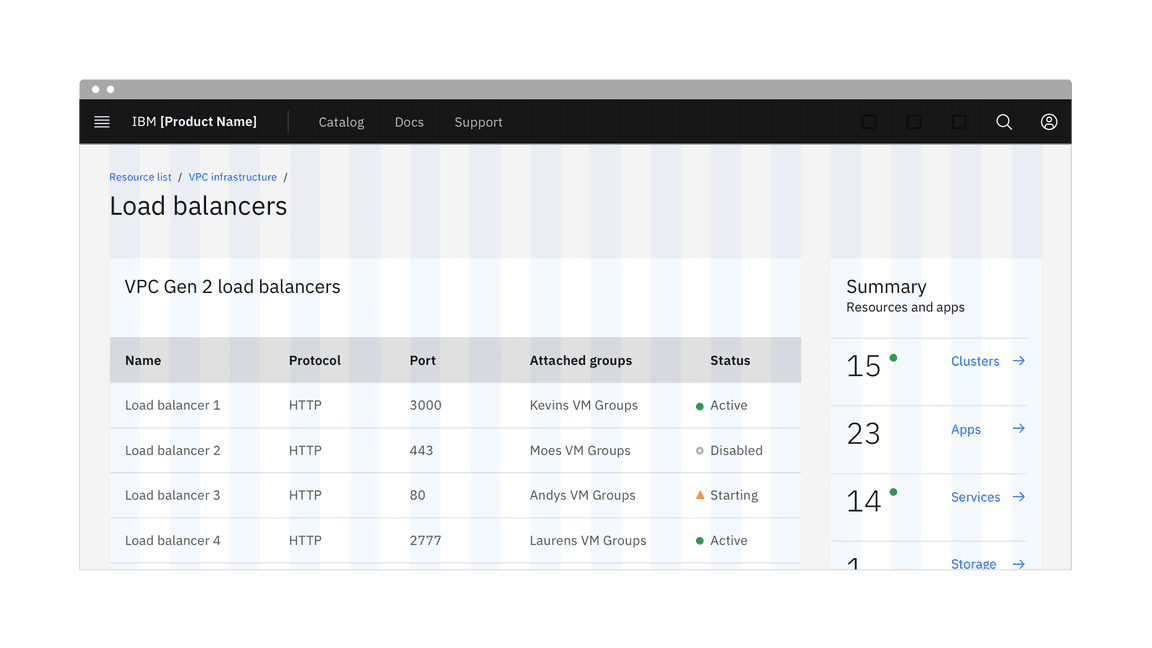
Data table on a wide (default) grid
Narrow grid mode
Using the data table on a narrow grid will hang the component into the gutter and create a desirable type alignment between the the data table’s title and other type on the page.
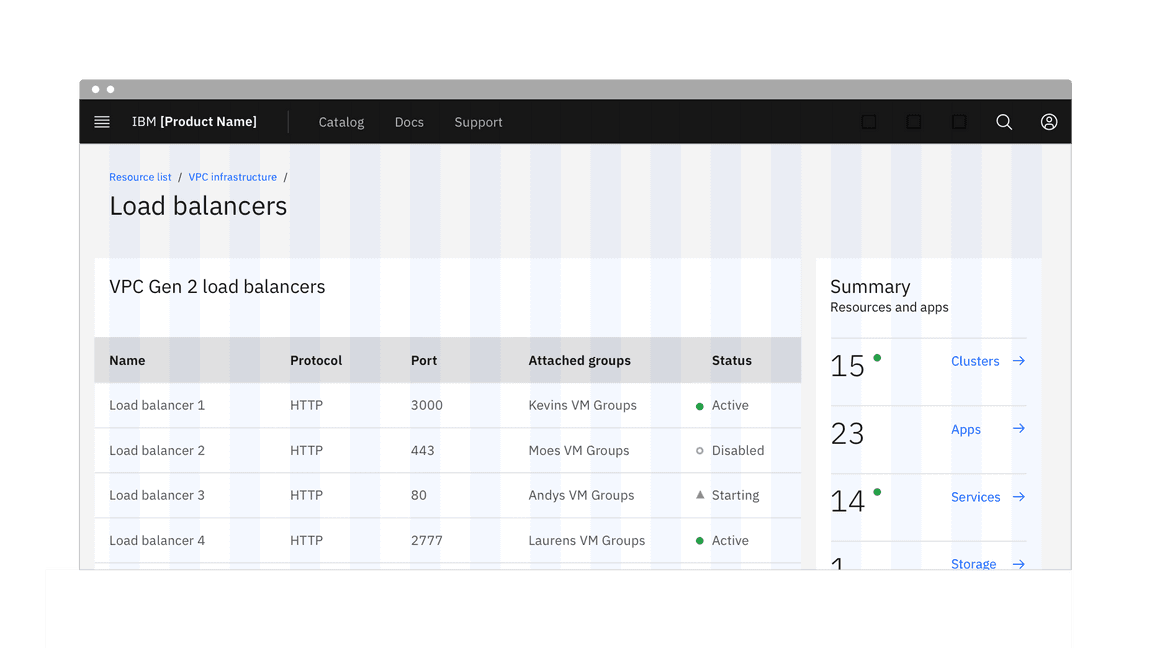
Data table on a narrow grid
Condensed grid mode
The data table can be used on a condensed grid, but care should be taken to avoid any unintentional relationships with other UI elements. Use a hybrid grid or a dissimilar background color to avoid the components blending in to each other.
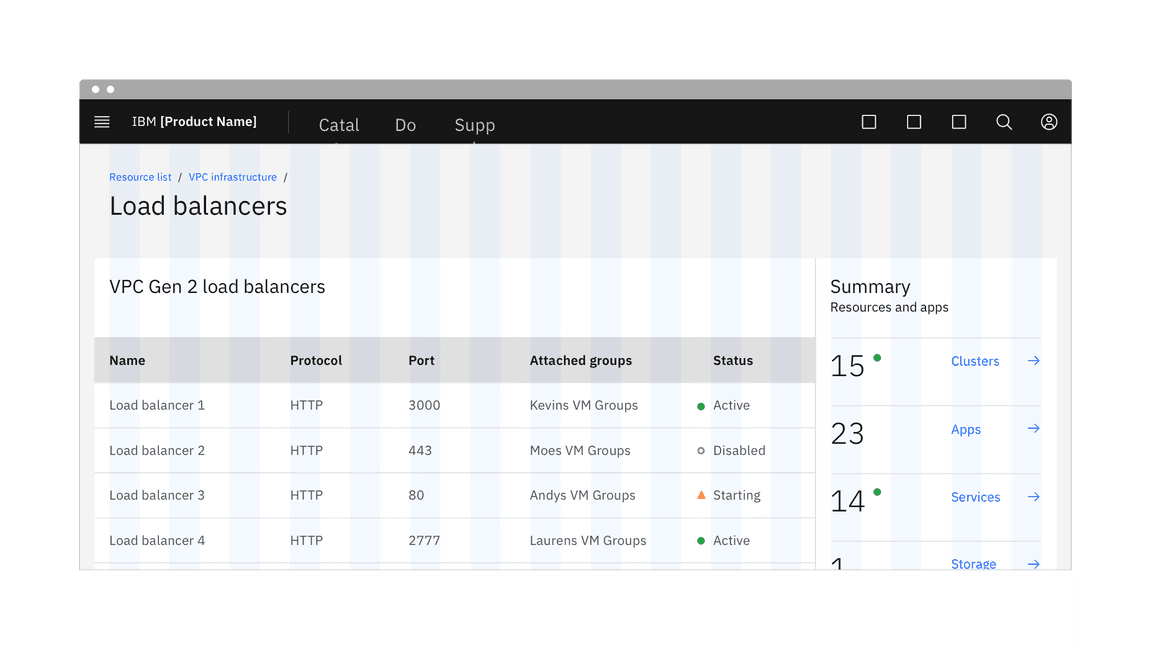
Data table on a condensed grid
Content
Main elements
Data table title and description
- The table title should make it clear to the user what this the data has in common and what purpose it serves in the UI.
- A description can be added under the title to provide more information about the data or its source.
- A data table’s title and description should use sentence-case capitalization.
Column titles
- Column titles should stick to one or two words that describe the data in that column.
- In cases where a column title is too long, wrap the text to two lines and then truncate the rest of the text. The full text should be shown in a tooltip on hover.
- Column titles should use sentence-case capitalization.
Primary button
- A data table using a primary action should follow the guidance for primary button usage and action labels.
For further content guidance, see Carbon’s content guidelines.
Behaviors
Interactions
Mouse
The data table’s toolbar and rows follow interaction conventions found in other Carbon components. Buttons, checkboxes, radio buttons, overflow menus, search, and expanding elements can be found in the data table and all behave the same way across Carbon components. See the style tab for detailed visual information about the various states.
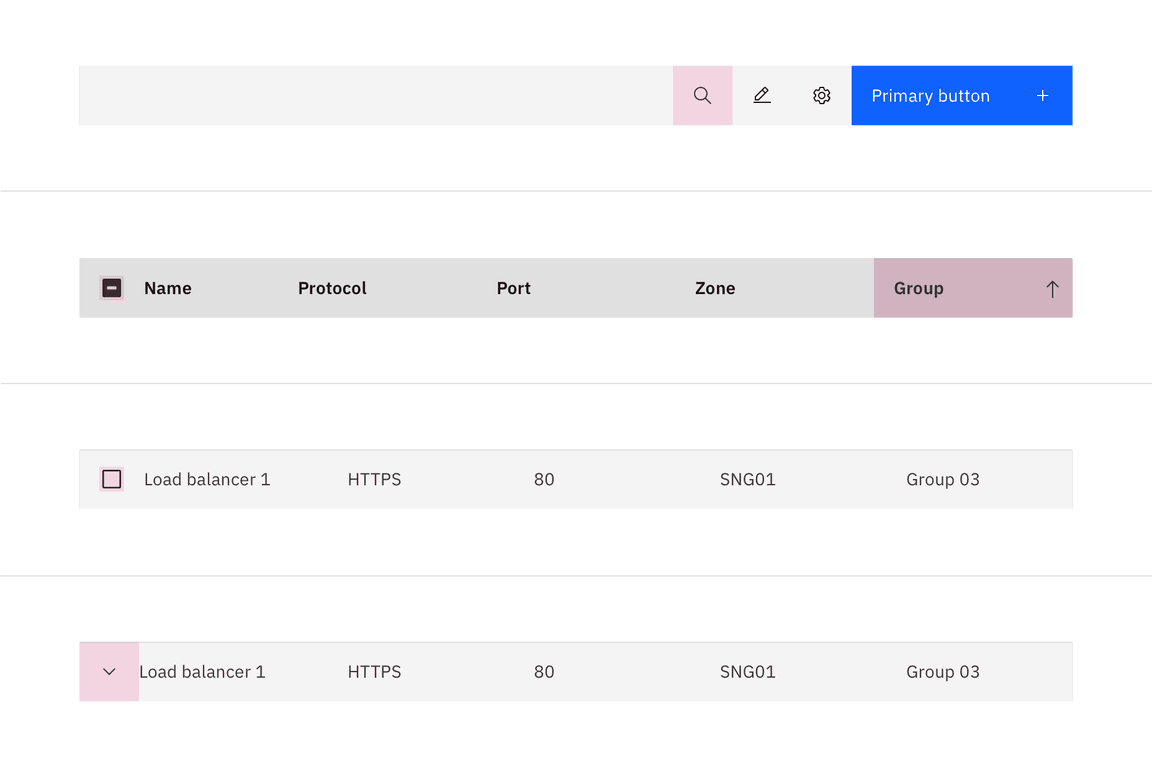
Highlighted target areas for data table mouse interactions
Hover
The data table’s row hover state can help your user visually scan the columns of data in a row even if the row is not interactive.
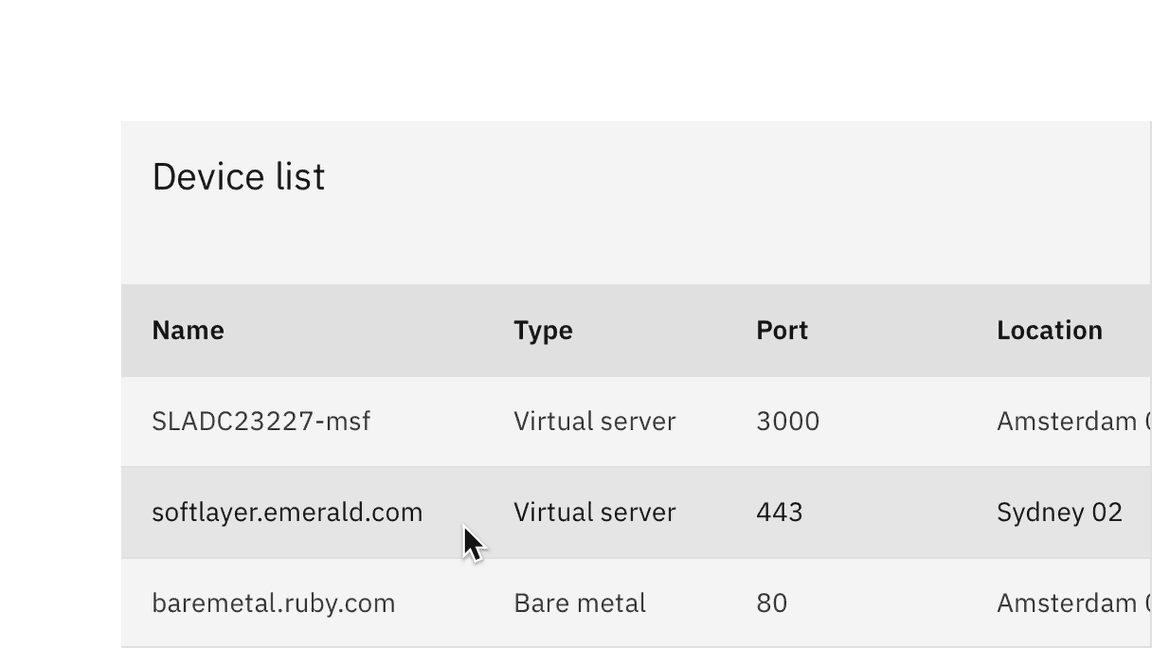
Pagination
Pagination divides table data into separate pages. Simple pagination indicates the current page in view and offers controls to incrementally navigate to the previous or next page. Advanced pagination is accompanied by an option that enables the user to change the number of items per page and to jump to a specific page number. The pagination component is always placed at the bottom of the data table. See the pagination component for further guidelines and configurations.

Simple (top) and advanced (bottom) pagination configurations
Search
Collapsed search
A search field can be triggered through an icon button in the data table toolbar. By default the search functionality follows the active search pattern. The search should be closed by default, and placed below the table title.
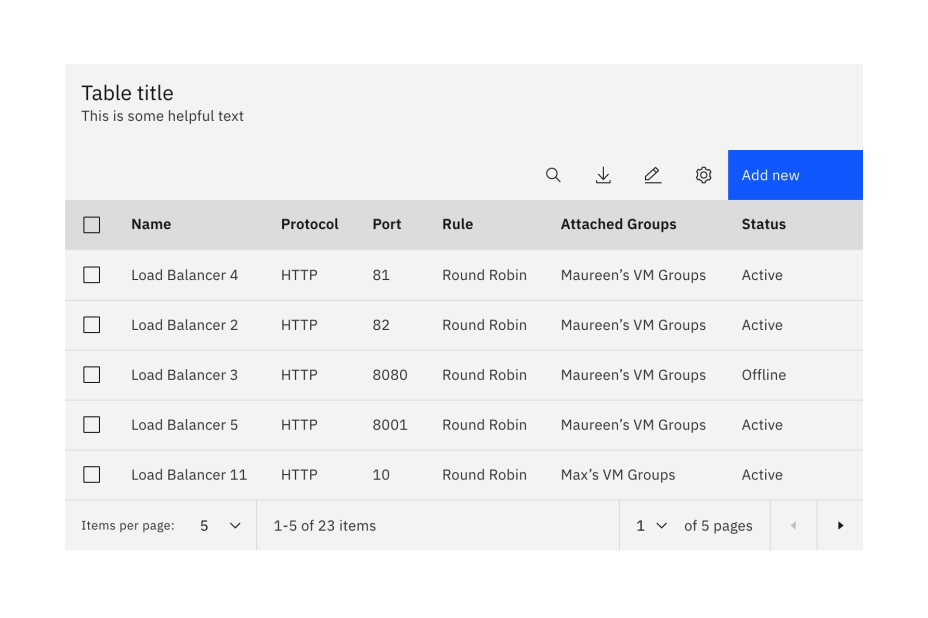
Open search
The search field can appear always open on a data table. The field is placed on the left side of the table under the table title and stretches until it meets the actions on the right.
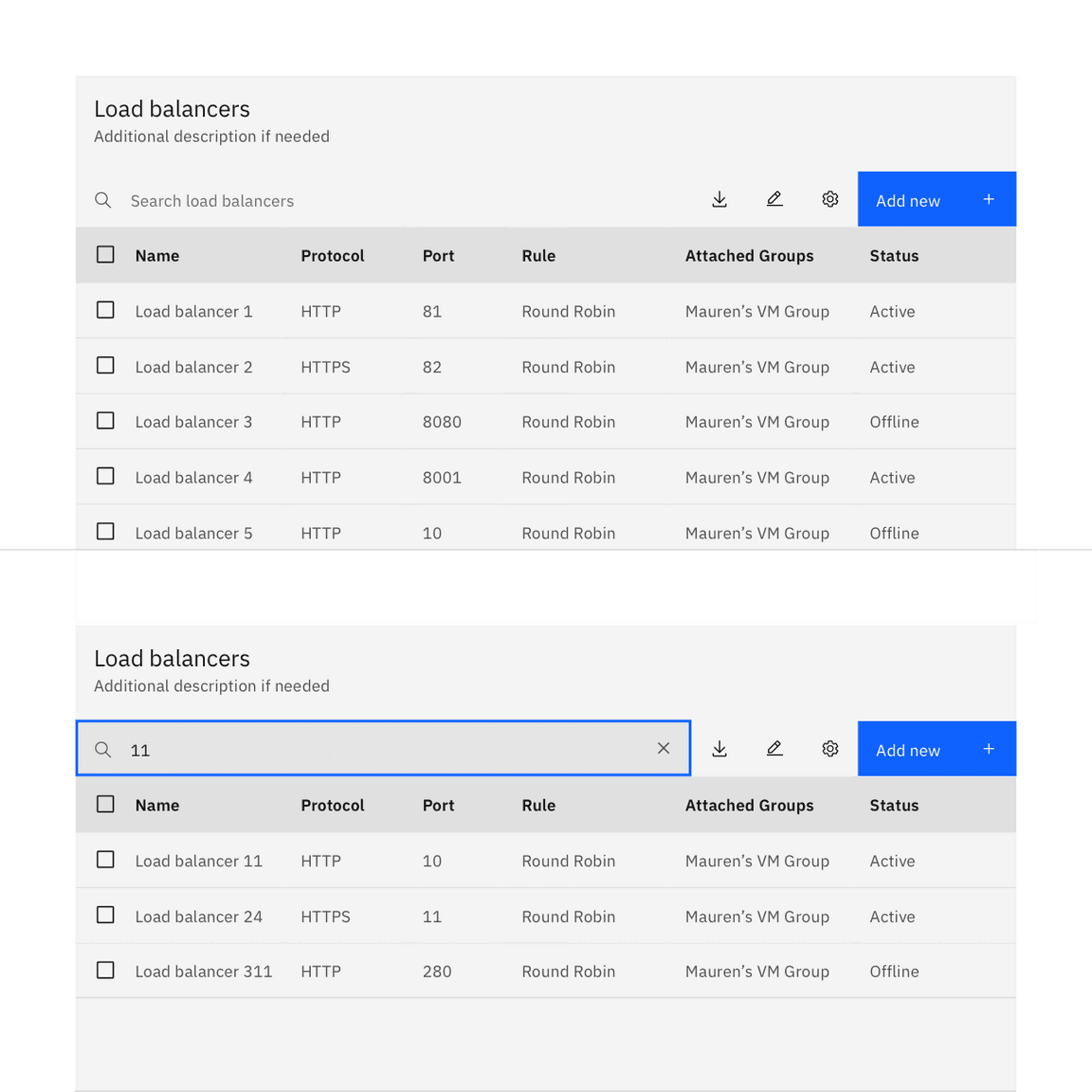
Sorting
Columns can be sorted in ascending or descending order. Sorting controls are located in the column headers and indicated with an arrow icon on hover and when a column has been sorted.
A sorted data table has three states: unsorted (arrows), sorted-up
(arrow--up) or sorted-down (arrow--down). The icon indicates the current
sorted state and is only shown if sorting is activated. Only the column being
sorted should display an icon, and unsorted icons are only visible on hover. You
can see a demo of table sorting in
Carbon’s React Storybook.
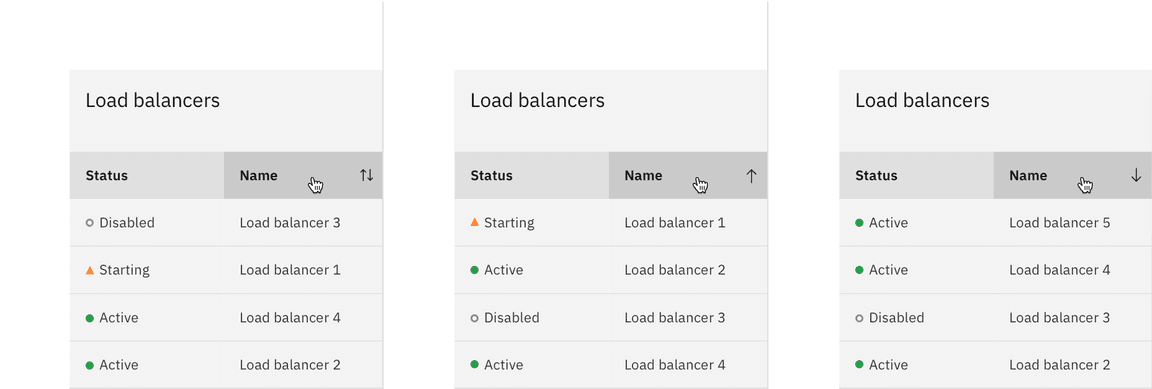
Table toolbar
The table toolbar is reserved for global table actions such as table settings, complex filters, exporting, or editing table data. Additional options can be added if you have an icon to support that function. Icons should be 16x16 px (glyphs). We recommend using no more than 5 icons within the table toolbar.
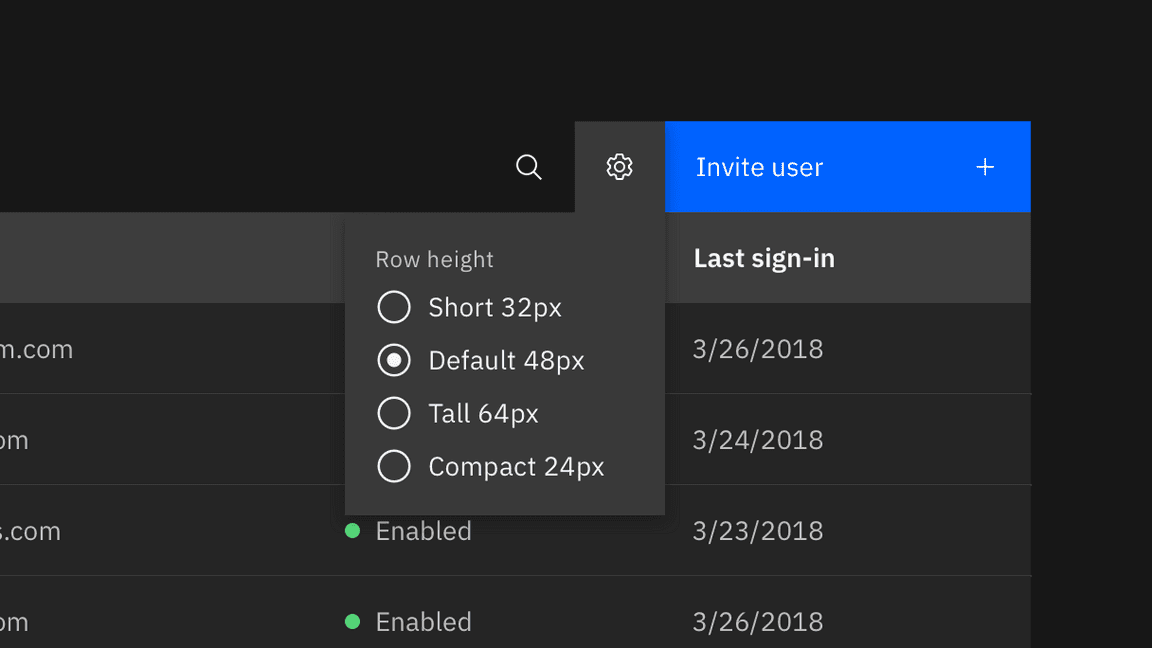
Multi-select & batch action
Batch actions are functions that may be performed on multiple items within a table. Once the user selects at least one row from the table, the batch action bar appears at the top of the table, presenting the user with actions they can take. To exit or escape “batch action mode”, the user can cancel out or deselect the items.
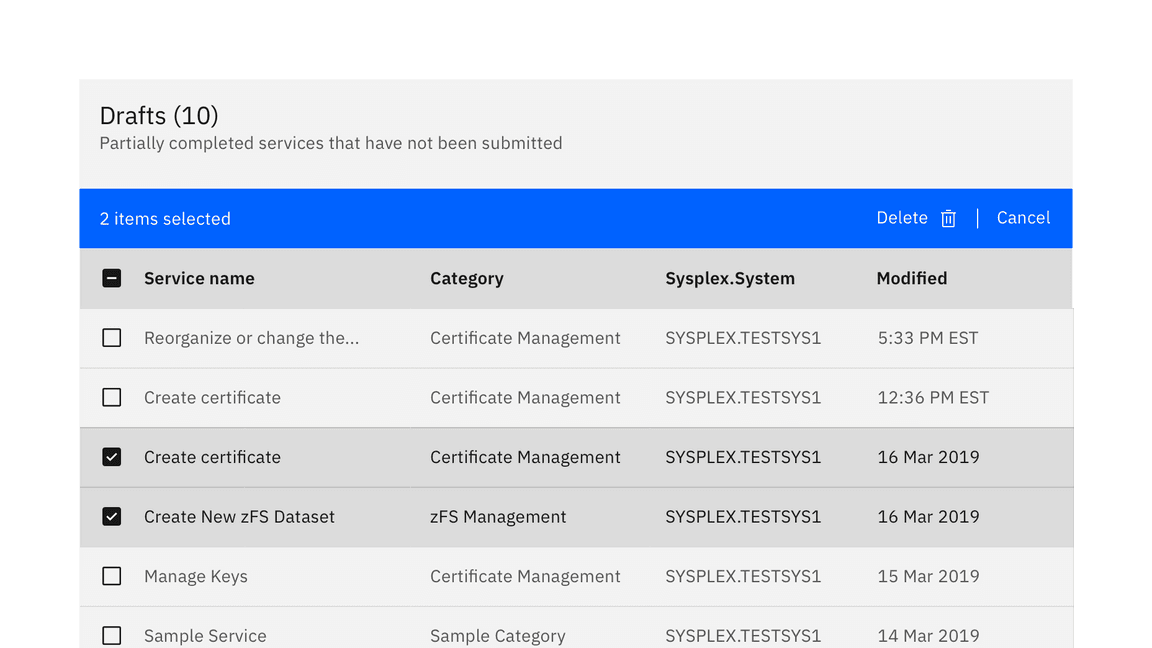
Radio selection
Instead of a multiselect checkbox function, the data table supports a single selection radio button control. Only one row can be selected at a time when using the radio selection. The radio button is placed in the first column on the left side.
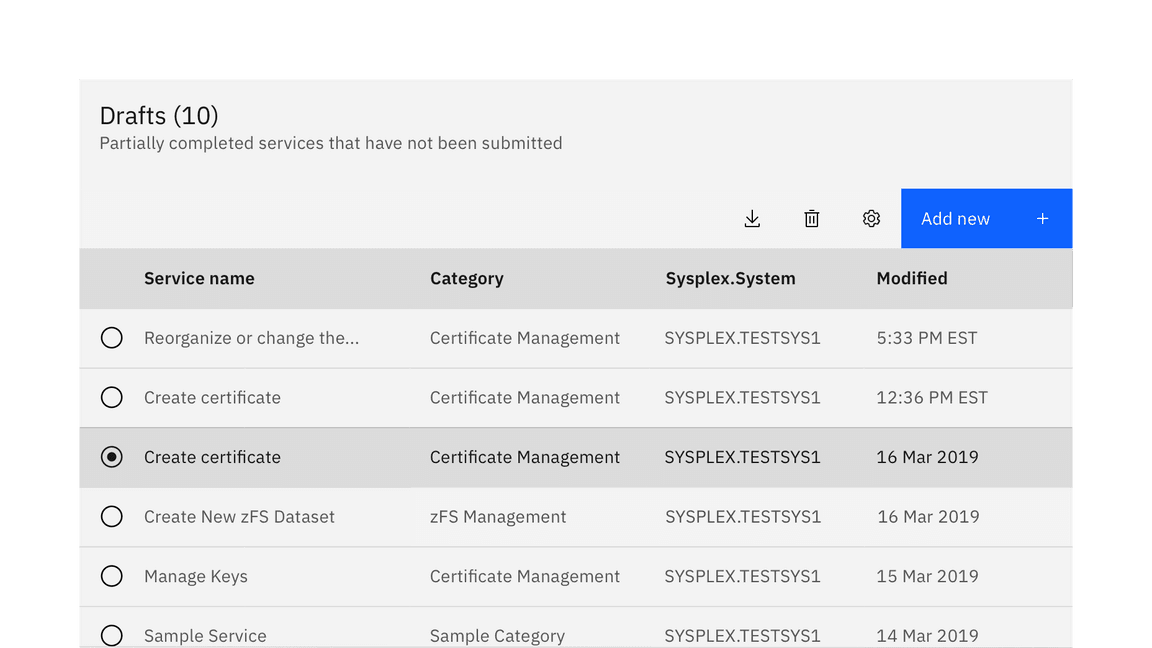
Inline actions
Inline actions are functions that may be performed on a specific table row. Each row is accompanied by an overflow menu that contains actions related specifically to that row.
When the overflow menu contains fewer than three options, keep the actions inline as icon buttons instead. This reduces a click and makes available actions visible at a glance.
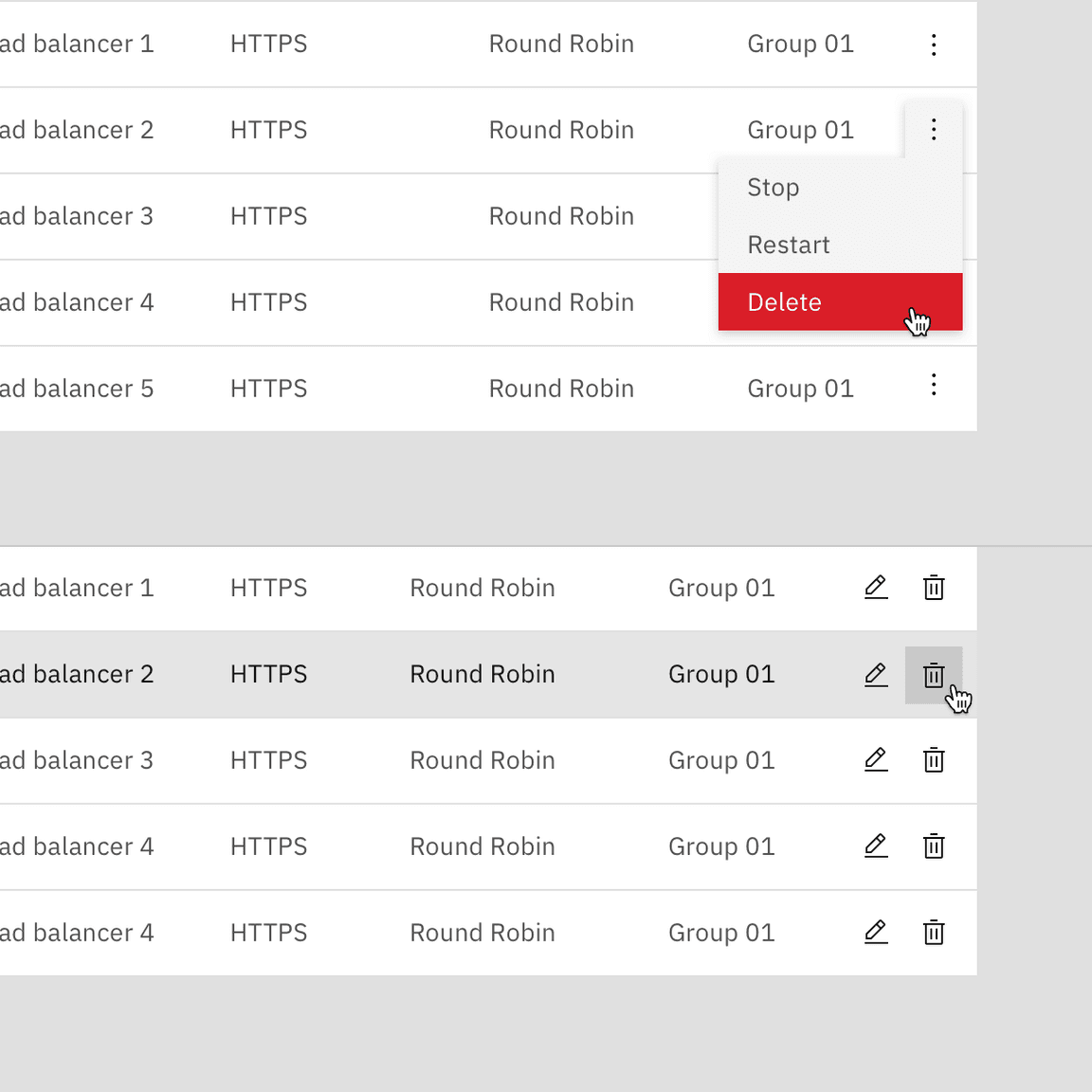
Overflow menu
By default, the overflow menu icons are persistent on each row. Having the
overflow menus always visible signals to the user actions can be taken on the
table rows. Alternatively, a product team may use the overflowMenuOnHover prop
to only show the overflow menu on hover and focus to reduce the visual clutter
of an overflow menu on every row.
For mobile and touch devices the data table will detect if the user agent
supports hover-over and persist the overflow menus even if the
overflowMenuOnHover prop is enabled.
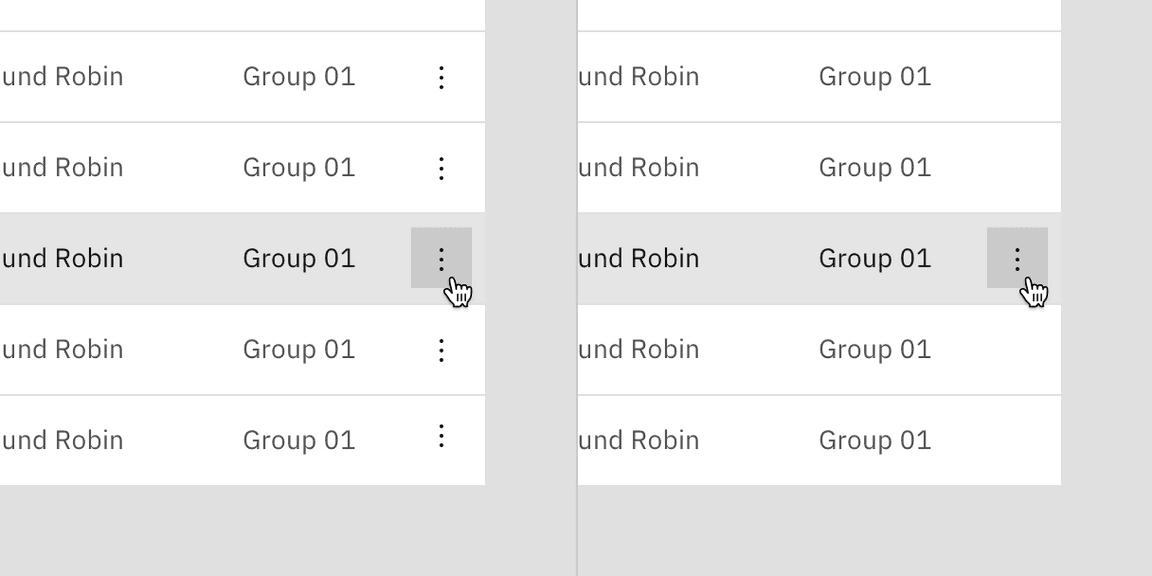
Persistent overflow (left), on hover (right).
Expandable
The expandable data table is useful for presenting large amounts of data in a small space. Use the expanded section for supplementary information or data that needs additional query time. When the content in the expanded area begins to feel cramped, consider taking the user to a dedicated page or opening a modal to view the information and complete tasks.

Expandable data table with one row expanded
Loading
By default, the expand-all chevron is not shown. Keeping detailed information in the expanded section saves user loading time by postponing some data queries until needed. Expanding all rows at once will typically negate this advantage of the expandable table. If additional load time is expected to display expanded information, use skeleton states instead of spinners.
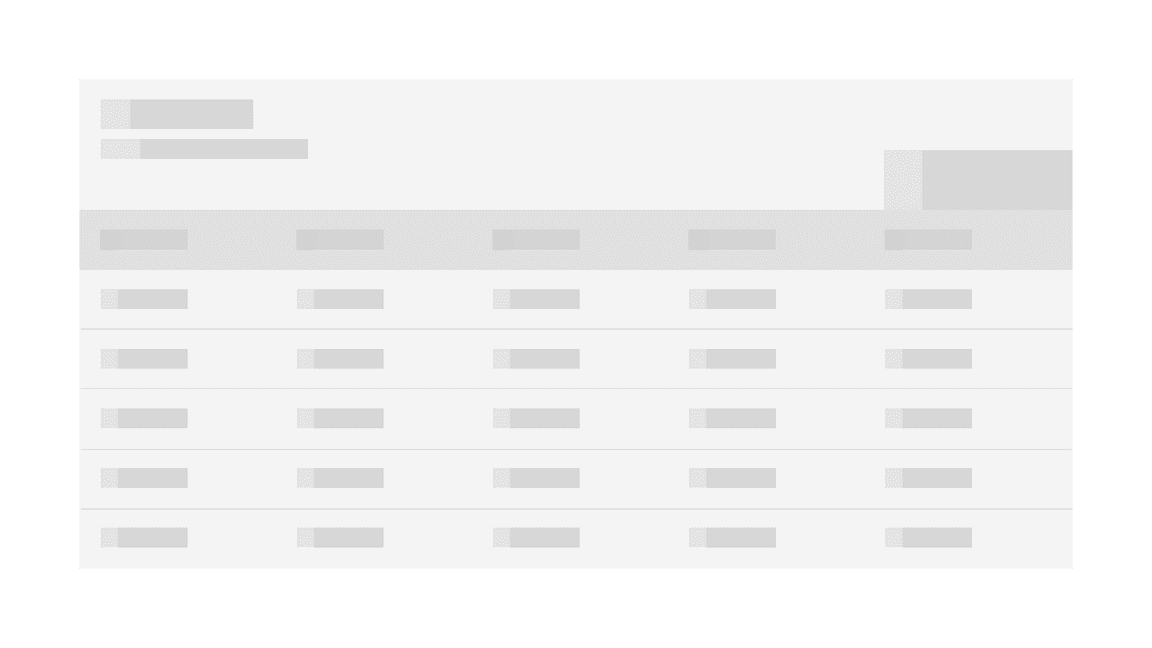
Expanding all rows with skeleton states
Modifiers
The data table features a zebra stripes modifier that styles the table rows with alternating colors to make scanning horizontal information easier for the user.
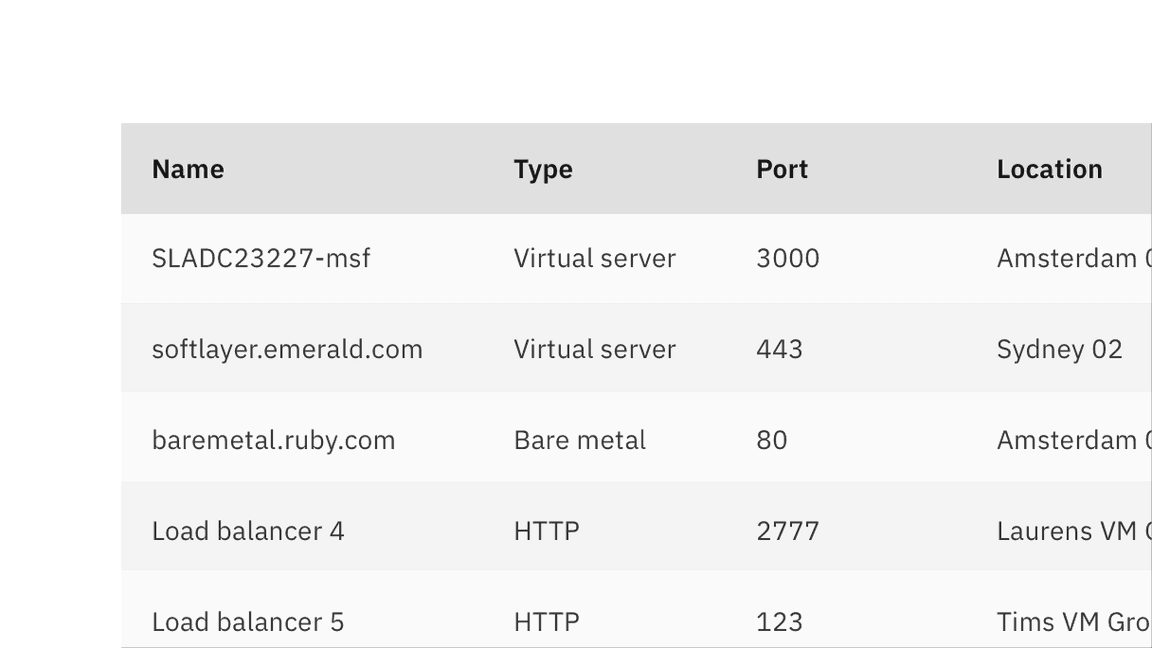
Related
The following components are additional ways to organize and navigate data.
Feedback
Help us improve this pattern by providing feedback, asking questions, and leaving any other comments on GitHub.